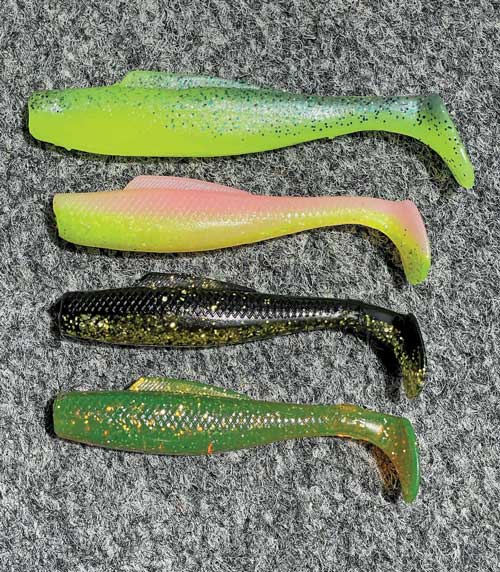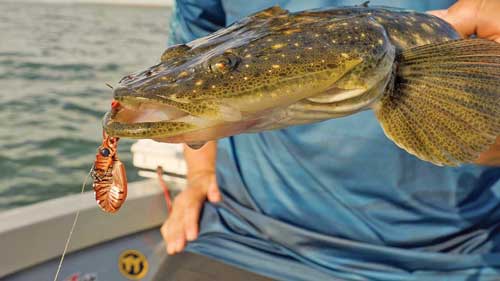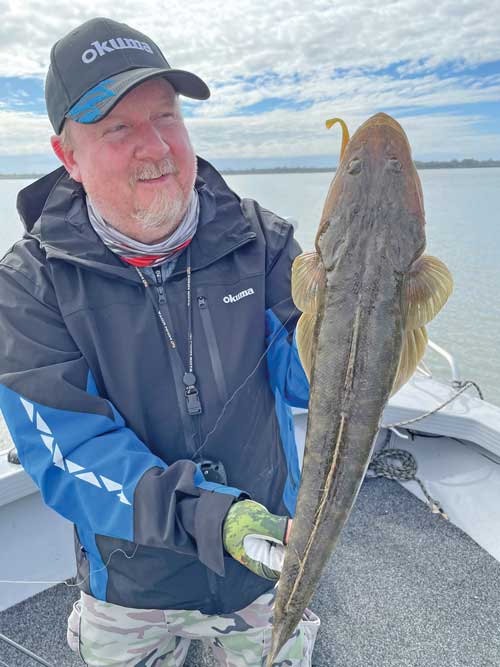With a lot of rain falling in many regions over the past couple of months, it’s common to be faced with dirty water when you head out for a fish, and this can in turn make the bite tougher.
In this article, I want to breakdown a few tactics that have helped me to consistently attract the bite in these challenging fishing conditions.
Lure action
When visibility is poor, we need to rely on other senses to assist the fish to find our lure presentation and a great starting point is lure action.
I predominantly fish with soft plastics, so my go-to presentations become those with plenty of in-built action, such as paddle tail and curl tail plastics.

This in-built action gives me confidence that the lure is ‘swimming’ on the drop, moving with the current flow when at rest and again, that tail will be working whenever I retrieve the lure.
This action creates vibration that is detected through the lateral line of the fish.
The other presentation that I commonly go to for these tougher dirty water bites is a vibe, such as a TT Quake Power Vibe as a soft vibe option or the Switchblade + and SwitchPrawn+ as a metal vibration blade option.
As their names suggest, these lures are designed to vibrate aggressively in the water, calling fish to the lure presentation and triggering strikes, which makes them a perfect option for dirty water fishing.

Lure noise
Fish not only sense vibration through their lateral line – running along the upper half of their body – but also through their ears (called otoliths or ‘ear stones’).
Put simply, otoliths are calcium structures behind the brain of the fish that interpret vibration or sound waves in the water as sound.
So lures with a lot of action in the water are sometimes referred to as ‘noisy’ presentations because they emit a lot of vibration in the water, while not actually emitting noise or sound as we would interpret it.
Therefore, to a fish, a vibe or plastic with a lot of action can be a noisy lure, again helping the fish to locate your presentation.

Some lures come with ‘noise’ added – as we would understand it – in the form of blades and rattles.
Hard-body lures with rattles added for example.
Another great option, especially in freshwater, is a ChatterBaitZ, spinnerbait or a jig spinner with blades designed to create more vibration and make the lure presentation easier to detect.
One new release I’ve been experimenting with and am super excited about is the Z-Man Rattle-Snaker, a tool that allows you to insert a glass rattle into your soft plastic presentation to add noise to your soft plastic.
Stay tuned because the Rattle-Snaker is going to be a game changer in some fishing scenarios.

Lure smell
As well as ears, fish have nostrils complete with small sacs that contain smell receptors designed to detect smells in the water that flows in and out of them.
As anglers, this gives us another avenue to attract the attention of the fish, especially when visibility is decreased and we are relying on other senses.
I am a big believer in applying scent to my lure presentations and my go-to is Pro-Cure Super Gel, with its gel base sticking to all lure types and only requiring a small amount applied every 30-50 casts.
I rub scent all over the lure to increase the surface area and dispersion of the scent.

Pro-Cure Super Gel contains real ground bait, as well as the techy stuff, such as amino acids, bite stimulants and ultraviolet enhancements.
It is ideal for masking foreign scents, such as fuel, sunscreen and bug spray, that may discourage the fish from biting, while also attracting and triggering strikes.
With a bunch of flavours available, you can match the scent to your presentation, target species or environment.
I commonly carry a baitfish scent, such as Mullet or Sardine/Pilchard and Saltwater Yabby/Nipper, to suit where I frequently fish.
So, we have chosen a presentation with action and noise, or added our own noise, and have now scented that presentation to increase our chances of attracting the bite… what else can we do to increase our chances of catching fish?

Lure colour
This subject is covered quite often, however it is also super important and one of the easiest variables for us to control.
I have frequently referred to a ‘three colour’ theory that I follow.
This is basically light and natural colours when fishing clear water and bright days, dark silhouette colours for low light and dirty water, with the UV/fluoro option in the kit in case nothing is working.
You may find a UV/fluoro colour that becomes your go-to, however I often start with the other two options first.

So, what are some go-to colours for dirty water?
I prefer solid colours rather than translucent colours and the addition of some glitter can catch the available light and attract fish.
My go-to dirty water colour would be Gold Rush (black back with gold glitter belly), with a couple of other solid dark colours thrown in.
The UV/fluoro colours are also ready to go, including Sexy Mullet, Electric Chicken and the proven Oil family of colours from Z-Man – Motor Oil, Midnight Oil, Blood Oil and Dirty Oil – with their fish-attracting UV pop.

Where to fish?
Okay, we’re pretty confident that we have the right presentation for fishing the dirty water, now where do we fish it?
It may sound a bit strange, however my first recommendation would be to find areas of cleaner water.
You may look out over the water and only see a brown mess, but look closer at what is going on and you’ll find areas that – based on current flow, tide, inlet points for stormwater, proximity to the ocean and other variables – are clearer, even if only slightly.
The mouths of systems will often be cleaner due to their proximity to the ocean and you can also chase the incoming tide, which often brings an influx of cleaner water into the system.

At times, the main channel can carry the dirty water on the dropping tide, while side arms and backwaters maintain better clarity.
Often, we have hunted sections of cleaner water and areas with defined dirty water lines and these areas have produced the fish.
Unfortunately, we have arrived at our destination and the water is brown as far as the eye can see, so where do we start?
In this situation, I generally start around weed beds because they maintain a higher level of salinity for longer periods, or I will fish the deeper sections of the system – the freshwater will flow over the top of the heavier salt water and the fish will frequently move deeper in the salt following rain.

In the fresh, the fish will often move right up into the newly flooded grass to feed on all the food that has been made available by the water rise, or up into the headwaters where food is being washed into the system.
As this flooded vegetation begins to rot however, you will find the fish move out of these areas and into the main channels and basins, where the water is more oxygenated and less contaminated.
It’s important to understand your target species though, as species such as bass and barramundi may stack up near the walls of impoundments in an attempt to head downstream when the rain coincides with spawning time.
Don’t forget the basics
There are two key factors that I will always go back to when fishing, and these become even more important when the bite is tougher, such as when fishing dirty water post-rain.
Those two key elements are structure and bait.
Regardless of when or where I’m fishing, my main focus is on locating the key structure in the system – be it manmade such as rock walls, stormwater drains and pontoons or natural such as drains, ledges, rock bars, laydown timber, weed edges and so forth.

Structure breaks up the water movement and creates eddies, pressure points, ambush points, shelter and attracts bait.
This brings me to the second point, bait.
There is an old saying that so often rings true and that is ‘find the bait, find the fish’.
Even after heavy rain, in dirty water the fish still need to feed, so pay attention to areas that are holding bait.
Schools of bait, bait flicking, bait on the sounder.
Wherever you can find bait, it’s worth spending more time fishing.
And don’t forget to try ‘matching the hatch’ by finding a presentation that closely imitates the bait in the area.
These are a few tips for fishing the dirty water that follows rain events and I hope they help you get hooked up to a few when the bite is tougher.
Remember also that your mindset is an important part of fishing, so go in to the session knowing that it may be tough and you may have to grind it out.
This will make each bite and fish more rewarding and, if you do happen to come across a hot bite, which can happen as the system begins to settle again, it may become one of your most memorable fishing adventures yet.
See you on the water.
 Bush ‘n Beach Fishing Magazine Location reports & tips for fishing, boating, camping, kayaking, 4WDing in Queensland and Northern NSW
Bush ‘n Beach Fishing Magazine Location reports & tips for fishing, boating, camping, kayaking, 4WDing in Queensland and Northern NSW










I just signed up this is so good these news letters will be great and I’m looking forward to seeing more thanks
thanks for the great article, keep up the good work